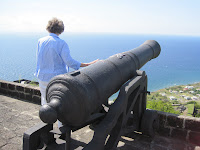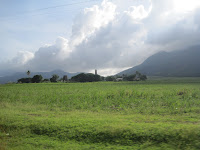Sunday, January 31, 2010
A tour of St. Kitts
We started off in the capitol city, Basseterre(where the Carnival was). The green clock tower is considered the center of the city. Independence Square is now a park but once was where slaves were auctioned. The big homes around the square housed in their basements the slaves waiting to be auctioned. The slaves were given their freedom in 1834. There is also a beautiful Co-Cathedral on this square as well as the current courthouse. We also stopped at the Anglican church in town.
We stopped briefly at some other sights and views. One place was a memorial to the war between the British and the Carib indians where it was said the Carib blood flowed from the battle field. We also stopped to see the nesting egrets. There were juvenile egrets in the tree waiting for their parent to bring them back food. They lofted high in the tree so the mangoose wouldn't get them.
Our first stop was at the Romney Manor, orignially owned by Thomas Jefferson's ancestors. It first was once a busy sugar cane plantation. It fell into disrepair post emancipation but in 1974 was purchased and repairs began. It now houses the Caribelle Batik business. There were many beautiful batiks displayed and for purchase. The manor also has lovely botanical gardens which are at the edge of the rainforest with Mt. Lumiagua nearby. The white flowered bush is named, "Snow on the Mountain."
We then travelled on north to the Brimstone Hill Fortress, a UNESCO national park. It was built by the English and the African slaves using the volcanic stones from nearby Mt. Liamuiga. The fortress is on a prominent hill on the northwest end of the island. It has beautiful views of the towns below, the Caribbean Sea and the island of Saba. On a clear day you can also see the island of Eustatius. Due to the volcanic eruption on Montserrat, the island south of Nevis, there was ash in the sky and we couldn't see Eustatius or St. Marten on the eastern side of St. Kitts. The British and the French had many battles to occupy the island of St. Kitts. The French ran a blockade off the coast of Brimstone Fortress and starved the British who finally surrendered. However, the French occupied the fort high on the hill for only one year before giving it back to the British! The stone gate leading into the fort complex is on a steep hill and a sharp turn - very difficult to maneuver vans and busses through! Click the link above for more info.
All along the route were small little villages. Some were fishing villages on the coast. We also saw goats everywhere! The goats go meandering off during the day to forage for food but know when to return home every evening. The villagers eat goat meat as a staple along with breadfruit, fruit (pineapple, papaya, mango, bananas) and garden vegetables. There are two schools in each village - the primary school for children to age 12 and then the secondary school from 12 to 18. The students in each school wear a school uniform. They looked very sharp! We enjoyed seeing the children walking home from school for lunch and after school.
We ate lunch at Rawlins Plantation on the northeast end of the island. It also had been a sugar plantation. We were the only ones there for lunch (we were late since we took longer to explore the fortress) and ate on the verranda. We ate a buffet of wonderful authentic Caribbean food: jerked chicken, curried chicken, johnny cakes,rice, sweet potatoes, pumpkin, tropical fruit, mango sauce...
We took two of the waitresses to their little villages after our lunch. At one village we could look out and see where the Caribbean Ocean met the Atlantic ocean. What a view.
What a wonderful day. Warm and humid, tropical and breezy, sunny and cloudy and full of great people and interesting sites!
Subscribe to:
Post Comments (Atom)

































1 comment:
How beautiful!
Post a Comment